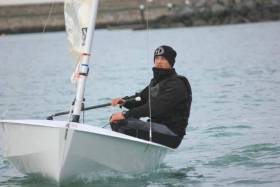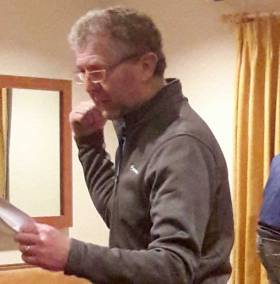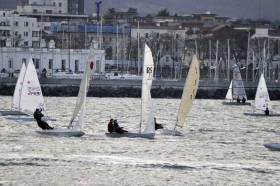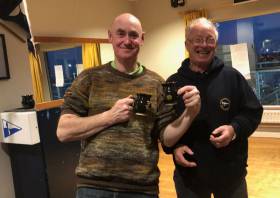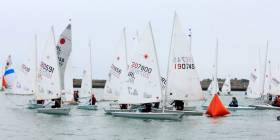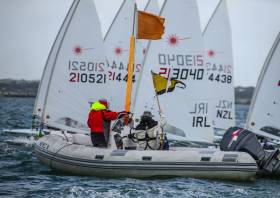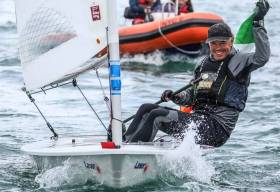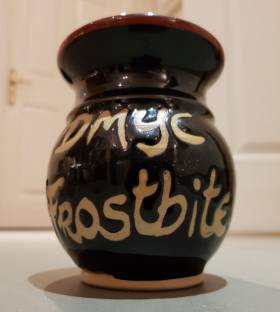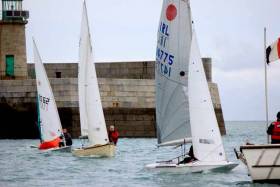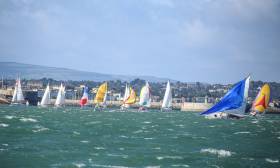Displaying items by tag: dmyc
Lack of Wind Cancels DMYC Frostbite Series for Second Week
Due to the pessimistic forecast, a decision to abandon yesterday's racing was taken early at the DMYC Frostbite Series at Dun Laoghaire on Dublin Bay. It's the second week in a row lack of wind has halted the series after the Christmas break.
A fleet of over 70 dinghies are contesting the long-running series
Challenging Day at DMYC Dinghy Frostbites
The fifth round of the DMYC-hosted Frostbites provided the fleet with the most challenging conditions yet and even then what was forecast didn’t really materialise. On Friday at the Fireball dinner and prize-giving the speculation was that we mightn’t get out at all. At that stage the forecast was for 6 knots gusting to 30 knots. On Saturday the harbour was reduced to mirror-like conditions, but the forecast for Sunday was starting to show that there would be wind the following day with the base wind strengthening but the gusts staying as severe as before. An early reconnaissance of the harbour in the committee boat suggested that the forecast conditions weren’t in place and the wind was blowing at 12 knots.
At the stage of the check on the conditions, the wind direction was 240⁰, but when we went out to set up the race course the wind had changed to a median direction of 180⁰ and the strength was showing signs of dropping.
This also meant that the original plan – to have a windward –leeward course to open proceedings, across the harbour in on east-west axis had to be abandoned in favour of an Olympic course with a weather mark situated to the west of the old HSS berth. That left the leeward mark sitting just inside of but in the middle of the harbour mouth and the gybe mark in towards the middle of the harbour.
Race Officer Cormac Bradley set a three-lapper for the first race and the PY fleets and Laser Radials both enjoyed clean starts. However, the combined Laser and 4.7 fleet found themselves in trouble with the Race Officer again, with another General Recall resulting in a restart under a black flag. Surprisingly………or not, the youngsters in the fleet were the principal culprits in “jumping the gun”.
In the PY fleet, Noel Butler & Stephen Oram (15061) led the fleet out to the left hand-side of the beat before working their way back to the right hand-side for the final approach to the weather mark on the starboard lay-line. A newcomer to the front end of the fleet was Dave Turner, sailing with Fireball stalwart “Cas” who rounded in second place. In close company was the remainder of the Fireball fleet, Phil Lawton & Owen Laverty (14990), Alistair Court & Gordon Syme (14706), Neil Colin & Margaret Casey (14775), the Thompson brothers (15007), another newcomer to the fleet, Josh, sailing with Class Chairman, Neil Cramer, in Frank Miller’s boat (14713) and Louise McKenna & Hermine O’Keeffe (14691). Also enjoying a place well up the pecking order on the water \was Shane McCarthy in the Solo. The Wayfarers had three boats on the water but their “champion” was in trouble with a premature start which necessitated going back – with the standard round the ends rule applying.
For the remainder of the race, an extended game of snakes and ladders was played with Turner falling to last at one stage. While Butler & Oram won on the water, they didn’t do enough time-wise to fend off McCarthy in the Solo who took another handicap win, followed home by Butler & Oram and Olympian Phil Lawton crewed by Owen Laverty, for whom this was enough to take the Frostbite Mug. Behind them the “new” Fireball combination of Josh and Neil Cramer came fourth, followed by the RS 200 of Sarah Byrne. The KONA Windsurfers were separated by a second in 6th and 7th respectively.
In the Laser fleets, race wins went to Niall Cowman (Standard), Conor Gorman (4.7s) and Finn Walker (Radials). Conor Kinsella, a very successful Fireball crew in recent times, made his Frostbite debut in a Laser Radial and finished just behind another class stalwart in Shirley Gilmore.
Given the prevailing conditions, of good breeze and a bright sky another Olympic was set, this time with four laps. However, the breeze soon increased as a rain shower made its presence felt and while the race course was on the fringe of the storm, a high wind speed of just under 20 knots was recorded. It also started flicking more significantly but the mean direction was still close enough to the original position of the weather mark. Yet again in the PY fleet, Butler & Oram were the boat to chase on the water, but Lawton and Laverty made it a much tighter chase with only 16 seconds separating them at the finish. McCarthy came home 4:16 behind Butler & Oram but on corrected time this was converted into a 57-second win. Court & Syme were an OCS who didn’t go back, while Tom Murphy in the K1 was a similar transgressor, who did take his punishment and went back to restart. The strengthening wind made for some interesting off-wind legs and a few of the Fireballs had “technical issues” as a consequence.
In the Laser fleets, wins were shared by Alan Hodgins (Standard), Alana Coakley (4.7s) and Conrad Vandlik (Radials). As the afternoon progressed the skies got greyer and it started raining making it the least comfortable afternoon of the series thus far. But after two races of the Olympic configuration there were no loud complaints about the day’s proceedings.
DMYC Frostbite Dinghy Fleet Benefit from More Healthy Winds
The fourth round of the 2018/19 DMYC dinghy Frostbite Series offered to be a healthy affair with a projected forecast of 10 – 14 knots from the east, a bit of sunshine and an air temperature of 6/7⁰. After a round of capsizes last weekend in the strongest winds of the series so far, a refresher on procedures was undertaken in the clubhouse before the racing. Some unique scenarios had arisen which needed a sharing of minds as to how to best manage them on the water.
Today’s complication on the water took the form of a barge carrying a large tonnage of granite rocks into the harbour, potentially, I think for repairs to the east pier seawall after the storms of last winter and beyond. While ribs were dispatched to manage the launching boats from the Royal St George and National Yacht Clubs, the barge made its way safely and unobstructed from the harbour mouth to St Michael’s Pier.
Race Officer Cormac Bradley (Fireball) decided on a three-lap windward-leeward course to start the proceedings as there was a good breeze on the water and it was a bright afternoon. With a weather mark set inshore of the Boyd Memorial on the East Pier, the 17-boat PY fleet favoured the outer half of the line and headed towards the harbour mouth. The fleet, made up of 8 Fireballs, the K1, the Wayfarer, the Solo, 2 RS200s and 2 RS400s, an Enterprise and Laser Vago worked the left hand side of the course but then found that they had forgotten the Sailing Instructions with respect to the leeward gate, with one high profile individual, who should know better, going round the outside of one of the two marks making up the gate as opposed to going through the gate………no names given, what happens on the water stays on the water!
Butler & Oram (FB 15061) did their normal thing when the breeze is up – they consistently sailed away from the fleet, winning by a margin of 2:18. One other Fireball, with an Olympian on board, forgot to go round the spreader mark at the top of the course; another Fireball went round the outside of the gate rather than through it. Between errors and retirements, the attrition rate in the PY fleet was quite high and Frank Miller & Ed Butler (FB 14713) sailed into second place on the water, followed by Louise McKenna & Hermine O’Keeffe (FB 14691) who finished ahead of Shane McCarthy in the Solo. While the Solo went up the pecking order on handicap, the Fireball was still a comfortable winner on corrected time. The Frostbite Mug went to the Fireball ladies, Louise and Hermine after a steward’s enquiry in the clubhouse afterwards.
The Lasers (Standard Rig) and 4.7s gave the race committee lots of grief today with a General Recall required in both races. Seven Standard Lasers had a good race with Ian Simington having a good win in the first race, but further down the pecking order three boats crossed the line overlapped, with Garvan Murphy picking up the first slot of those three. Unfortunately for him it was too far down the pecking order to be in the 1-2-3, those latter positions going to Gary O’Hare and Niall Cowman. That gave Cowman the Frostbite Mug. In the 4.7s, a young lady led the fleet home with a win for Alana Coakley, followed by Conor Gorman, (Dad happy for the second week in a row) and Adam Walsh. Hugh O’Connor picked up the Frostbite Mug.
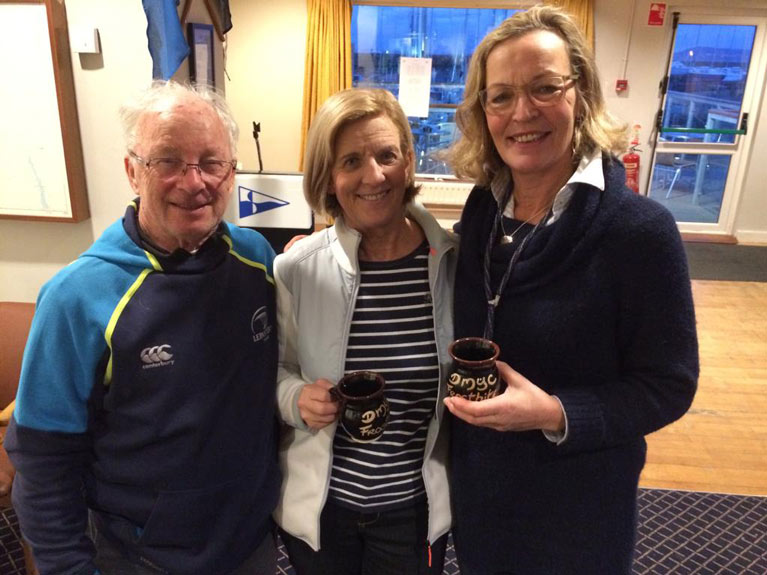 PY Mug winners in Race 1, Louise McKenna & Hermine O’Keeffe, Fireball 14691 with DMYC Commodore Frank Guilfoyle, Photo Frank Miller.
PY Mug winners in Race 1, Louise McKenna & Hermine O’Keeffe, Fireball 14691 with DMYC Commodore Frank Guilfoyle, Photo Frank Miller.
In the Laser Radials, there was a win for another young lady in Claire Gorman, (the cup runneth over, Dad), followed by Jack Fahy and Marco Sorgassi. The second place was enough to get the Frostbite Mug for Fahy.
Race2 was a three-lap Olympic course in a slightly lighter breeze, for although the weather still wasn’t too bad, for the PY fleet there had been a long break between races. The reduction in the number of marks to be rounded made the race easier for most and a more ordered rounding of the race course resulted. Again the outer end of the line was preferred and again, Butler and Oram did their thing. This time however, the rest of the Fireballs gave them a bit more company before they fell back to have their own race for the podium places on the water. Eventually the finishing order on the water would be Butler, Neil Colin & Margaret Casey (FB 14775), Phil Lawton & Owen Laverty (FB 14990), McKenna & O’Keeffe (FB 14691), Miler & Butler (FB 14713), the RS200 of Sarah Byrne & Helen Craig and the Solo of McCarthy. The latter two did enough on the water to form a handicap podium of Butler, McCarthy and Byrne to give the Frostbite Mug to the RS 200 crew. Colin was fourth on handicap ahead of the Wayfarer of Monica Schaeffer and Norman Lee.
In the Standard Lasers, there was a repeat win for Ian Simington, but Gavan Murphy had a better race to finish second, ahead of Chris Arrowsmith and Niall Cowman. In the 4.7s there was another “double” when Alana Coakley again led the fleet home, followed by Gorman, Walsh and Hugh O’Connor. As these were all Mug winners already, the Mug went to Oisin Hughes in fifth.
In the eleven-boat Radial fleet, the younger generation found the slighter lighter wind conditions more favourable and they led the fleet home – Jack Fahy, Conrad Vandlik and Claire Gorman, were the 1-2-3, followed by Marco Sorgassi and Moss Simington. This fifth place earned Moss the Frostbite Mug.
While this column isn’t generally intended to be a notification for issues associated with the Sailing Instructions, it enjoys a healthy readership when it appears on the Afloat website. On the assumption that a lot of those readers are from the fleet, with the agreement of the principal organiser of the Frostbites, Neil Colin, a piece of advice, when the blue flag is flying to indicate that the committee boat is on station for a finish, competitors still racing are NOT allowed to cross the line.
With the Irish Universities having a 70th team racing event in Dun Laoghaire Harbour over the weekend, with 71 races completed on Saturday and various training initiatives taking place inside (and outside) the harbour, Race Officer Neil Colin (Fireball) was challenged to get his DMYC Frostbites race course in yesterday for the third round of the 2018/19 Frostbites, with an easterly of 10 – 16 knots forecast for the day. Earlier in the morning the keelboats’ Turkey Shoot had attracted a record entry of 75 boats (a statistic gleaned from another article on a popular website) but not to be outdone, the dinghy fraternity mounted a robust attendance for the first race of the day with 55 entries across the three starts. The start area was in the outer western corner of the harbour, between the mouth and the western bight with the committee boat no more than 50 – 60m upwind of the inner wall. Given a heavy swell that was washing up on the rocks, it was a slightly unnerving feeling to have so many boats sailing up and down in such a confined area.
Race 1 of the day was a two-lap Windward – Leeward and the bulk of the fleet went off on starboard tack towards the end of the West Pier. As to be expected, Noel Butler & Stephen Oram (FB 15061) were quick out of the blocks, but your correspondent, crewing for Alistair Court (FB 14706), also got away cleanly pulling away from Frank Miller & Grattan Donnelly (FB 14713). The longer tack was the port tack up the length of the harbour towards the East Pier with the weather mark in the approximate vicinity of the Boyd Memorial. With that bit more weight on the wire, Court was able to sail a higher line and had closed to a distance that necessitated a call of starboard when Butler & Oram came across on what they thought was an approach to the weather mark. Except, they chose the wrong mark, going for what was a sizeable spreader mark and on rounding it, launched their kite. Court and Bradley went round the weather mark and found that they were in company with Miller & Donnelly. The initial part of the downwind leg was a broad reach to the western end of the harbour mouth, followed by a gybe to get towards the leeward gate. Except that was like getting through the rush of a train platform as the Lasers were making their way upwind and going through the start line was taboo……….though some may have done this.
Court rounded in the lead and up the next upwind leg was able to stretch his advantage again with Bradley’s bigger weight on the wire, though he is lighter than this time last year! However, Miller & Donnelly were not to be outdone and came back at them on the off-wind leg. A poor drop by Bradley going through the gate allowed Miller to close even more but Court squeezed the win on the water by a margin of 4 seconds over Miller, with the Thompson brothers, sailing Louis Smyth’s boat, 14007, next 16 seconds later and the unusually errant Butler & Oram next home in 15:27 minutes only 40 seconds behind the winners. The question was did Court’s Fireball have enough on Shane McCarthy’s Solo to take the win and maybe a Frostbite Mug. The answer was No on both counts, despite being just short of two minutes down on Court’s finishing time, McCarthy won by 1:14 on handicap and the Kona Windsurfer of Des Gibney took second and the Mug by a four-second margin on the Fireball.
In the Laser Full Rig Class the race win and Mug went to the Dun Laoghaire Laser Class Captain Gavan Murphy followed home by Chris Arrowsmith and Conor O’Leary, the latter having sailed 6 one-lap Flying Fifteen Frostbite races the day before in the last round of 2018 racing for the DL Flying Fifteen fleet.
In the Radials, the race win and Mug went to Sean Craig, ahead of Marco Sorgassi and Conor Clancy, formerly of the Fireball Class. In the 4.7s, the race win and Mug went to Adam Walsh, followed by Alana Coakley and Conor Gorman.
For the second race of the day a four-lap Olympic configuration was set and the attrition rate started to kick in as the combined entry for this race was down to 44 boats. The weather mark stayed pretty much where it was and the spreader mark was converted to a gybe mark and located just inside the end of the West Pier. Again the consensus was to get off the start line on starboard and head towards the West Pier. The Thompson brothers and Butler & Oram had the best starts of the second race while others were adversely affected by the presence of a Laser 4.7 who was in the wrong place at the wrong time…….in irons. We were all genteel in our language in advising him what he should be doing. Having broken free of the melee, Louise McKenna & Hermine O’Keeffe (FB 14691), Miller and Court found themselves in VERY close company but Court was able to power out between the two. Butler & Oram were never headed off the start line and the race for second, on the water featured Court, Miller and the Thompsons. Upwind, Court held the upper hand being able to sail much closer to the wind without losing boat speed whereas Miller and Thompson sailed that bit further off the breeze. It invariably meant a coming together in the vicinity of tacking for the starboard lay-line, with Court being “Starboard- hailed” on more than one occasion on the beat. But over the first three beats, Court eked out a lead going upwind which Miller and the Thompsons reduced on the downwind legs. It had been blustery all day, not wipe-out strength, but there were upturned boats on the course as gybes and windward rolls took their toll. On the last beat Court and Bradley were knocked over and filled the cockpit with water, enough to cause their good work earlier to evaporate.
Butler & Oram won by 1:35 on the water over Miller & Donnelly in a race that lasted 24:12, with the Thompsons next home in 26:30, 43 seconds behind Miller and just nine seconds ahead of Court & Bradley who had a second on McKenna & O’Keeffe. McCarthy was 2 seconds short of being five minutes behind Butler & Oram on the water, but on corrected time closed that gap to just seven seconds. With Des Gibney third, Miller & Donnelly picked up the PY Mug for the second race.
In the Lasers, the win and Mug in the Standard Rig went to Ian Simington, followed by Peter Fagan and Gavan Murphy. Adam Walsh took the Laser 4.7s on the water, followed home by Alana Coakley and Conor Gorman. That was good enough to give Conor the Race Mug and considering he has recently come out of Optimists, on the basis of age, this is a great result. His sister is a previous Mug winner in this Series (Day 1 Radials) so Dad Dave, the current Flying Fifteen National Champion, must be “chuffed” at their success. In the Radials, the one-two was repeated by Craig and Sorgassi but this gave Marco Sorgassi the Race Mug, with Jack Hall in third place.
48th DMYC Frostbite Series Gets Underway in Dun Laoghaire Harbour
The 48th hosting of the Dun Laoghaire Motor Yacht Club’s Frostbite Series got underway yesterday, Sunday 4th November with an entry of 93 boats confirmed during the morning of the first Sunday. This represents a huge increase from last year and is due in substantial part to a big influx of Lasers which are in such number that they are now split across two separate starts; Standards & 4.7s followed by the Radials. Another fleet with good numbers was the Fireball Class who had nine boats on the water
After a review of last year’s Frostbites and a survey of the participants a number of changes have been made which will be assessed as the season progresses. Among these are;
- A desire for more races on the day
- A move away from the reaching legs of the trapezoid
- Shorter duration races and faster turnaround times
Yesterday Dun Laoghaire harbour was more akin to “Piccadilly Circus” the Frostbite fleet racing mid-harbour, a group of Toppers being coached in front of the National Yacht Club and a group of INSS sailors sailing in the vicinity of the green pontoon off the western bight. The fact that there was very little wind to achieve any of these ambitions is testament to the perseverance of those who had organised them and those who took part!
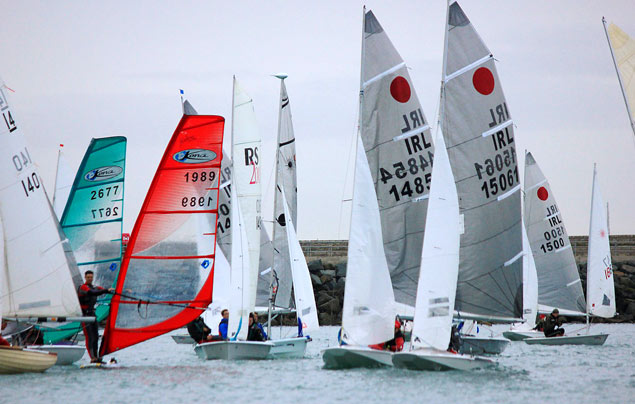
Race Officer for the Frostbites, Ben Mulligan, of the Flying Fifteen fleet, had his work cut out for him in trying to set a course for the first race with the wind being very fickle and in very short supply! Eventually, he settled on a triangular course with the committee boat set up in the middle of the harbour and a weather mark in the direction of the East Pier.
With a single PY Class the first start of the day, we were treated to a fleet that had Shane McCarthy’s Solo, the K1 of Tom Murphy (Flying Fifteen), the Enterprise of Aidan Geraghty & Bernadette Fox, the RS Aero 9 of Paul Phelan, RS200s, RS400s, Frank Hamilton’s IDRA, a two-handed Mirror and a single-handed Mirror, the returning Kona Windsurfers of Robbie Walker & Des Gibney, a 2.4m sailed by Patrick Hassett, the Wayfarer of Monica Schaefer, one of at least three, and the “Sailing in Dublin’s” Laser Vagos and the aforementioned Fireballs.
What had been set out as a beat, turned into a two sail fetch about halfway up the first leg and at the fore was the combination of the Cariosa Power & Marie Barry (FB 14854). Another, all-lady combination from the Fireball Class was also well placed in the leading bunch, Louise McKenna & Hermine O’Keeffe (FB 14691) taking advantage of a good start and the lighter winds. After missing last year’s Frostbites due to medical issues, the serial winners of the Fireball Frostbites, Noel Butler & Stephen Oram (15061) were back on the water but found themselves in the unusual situation of being well back in the fleet and in the pecking order of the Fireballs. For those who were even further back, due to a poor start, the engagement was with the leading Laser who started 3 minutes after the PYs, the Enterprise and Schaefer’s Wayfarer.
Power & Barry maintained their lead down what was supposed to have been the first reach which had turned into a broader reach on the opposite tack and rounded the leeward mark in pole position, where they, like everyone else to follow behind them, was greeted with a rib flying the “V” flag and making sound signals – Go straight to the finish! They proceeded to do so, scoring a thirty second margin over the second Fireball and finisher – McKenna & O’Keeffe. On the water, the pecking order was Fireball, Fireball, Solo, RS Aero 9, Fireball (Court & Syme, 14706), Fireball (Butler & Oram), Fireball (Miller & Bradley, 14713), Fireball (Turner & Turner, 14362), Fireball (Colin & Casey 14775) and Kona Windsurfer (Walker, 1989). However, the leading Laser had also infiltrated that finishing sequence.
After a slightly longer break waiting for any worthwhile wind to settle in a second race got underway from a new direction, necessitating a complete change of course. The committee boat went northwards and the weather mark moved from a position approximately in front of the National and George Yachts Clubs to a position to the west of the HSS ferry gantry. However, it also had the decency to blow a bit harder and consequently, the PY fleet was able to get off the start line cleaner and more efficiently meaning that they were free of the Lasers.
“Proper order” was restored when Butler & Oram led the PY fleet into the first mark and proceeded to do what they normally do – stretch their lead over the rest of the fleet. To put this in context, in a race where their finishing time was 22:59 minutes, they had a 1:07 margin on the next boat, the Fireball of Colin & Casey. A two-lap triangular course was the recipe for the second race and all the component parts were in the right place, two spinnaker reaches and a gybe at the right location and despite the fickle wind some brief moments of off-wind trapezing!!
Further back the mid-class Fireballs were mixing it with the RS 400s and the leading Wayfarer…….again, but the breeze that had appeared meant that there was sense that one was in control of one’s destiny and some manoeuvres could be contemplated.
The finishing order of the race was; Fireball (Butler & Oram), Fireball (Colin & Casey), Fireball (Court & Syme), Fireball (Power & Barry), Fireball (Turner & Turner), Fireball (Thompson & Thompson, 15007), the beneficiaries of the Louis Smyth loaned boat scheme, Fireball (Miller & Bradley), Solo (McCarthy) and the K1 of Tom Murphy.
At the delayed daily prize-giving in the DMYC clubhouse, there was much anticipation – Could Cariosa and Marie win the first Frostbite Mug of the PY fleet (and the Fireballs) and disrupt an almost seamless sequence of opening race wins by Noel & Stephen? Given that the Fireballs were now racing in PY there was no guarantee that the opening race Mug would go to the Fireballs, but if it did it would be quite a coup for the girls! And the winner is…………Shane McCarthy in the Solo with a corrected race time of 14:23 relative to 16:11 of the Fireball! Cariosa and Marie were the leading Fireball but on corrected time were scored in 4th place behind the Solo, Schaefer’s Wayfarer and the IDRA of Frank Hamilton & Jennifer Byrne.
In the second race, the corrected time result also gave the race win to McCarthy but this time by a tighter margin of 3 seconds over the Fireball of Butler & Oram. As McCarthy had the Mug for race won, Butler & Oram took it for the second race and so, the effort to unseat Butler and Oram as the first Mug winners in the Fireball Frostbites runs for another year.
Suggestions that a recount was demanded are categorically refuted!!
In the Lasers, the pecking order of results showed an encouraging trend of mixes in the top end results with the 4.7s taking on the Standard Lasers in Race 1 and the Radials doing the same in race 2. The Radial fleet is also populated by Juniors coming out of other classes and the large numbers on the water yesterday was a very encouraging sight.
|
48th Frostbite Series – Hosted by Dun Laoghaire Motor Yacht Club 2018/19 |
||||
|
Race 1 |
PY Class |
Lasers |
||
|
1 |
Solo |
Shane McCarthy |
Standard |
Chris Arrowsmith |
|
2 |
Wayfarer |
Monica Schaefer & Norman Lee |
Standard |
Gary O’Hare |
|
3 |
IDRA |
Frank Hamilton & Jennifer Byrne |
Laser 4.7 |
Adam Walsh |
|
4 |
Fireball |
Cariosa Power & Marie Barry |
Laser 4.7 |
Hugh O’Connor |
|
5 |
RS Aero 9 |
Paul Phelan |
Laser 4.7 |
Alana Coakley |
|
6 |
Kona Windsurfer |
Robbie Walker |
Standard |
Conor O’Leary |
|
Race 2 |
PY Class |
Lasers |
||
|
1 |
Solo |
Shane McCarthy |
Laser Radial |
Clare Gorman |
|
2 |
Fireball |
Noel Butler & Stephen Oram |
Standard |
Gary O’Hare |
|
3 |
Fireball |
Neil Colin & Margaret Casey |
Standard |
Niall Cowman |
|
4 |
K1 |
Tom Murphy |
Standard |
David Cahill |
|
5 |
IDRA |
Frank Hamilton & Jennifer Byrne |
Standard |
Chris Arrowsmith |
|
6 |
Wayfarer |
Monica Schaefer & Norman Lee |
Laser Radial |
Judy O’Bierne |
DMYC Frostbites Attracts 54 Laser Dinghies for Sunday's First Race of 2018/19 Series
54 Lasers across three divisions, out of 86 overall entries to date has prompted a rethink of starts for tomorrow's first race of the DMYC Frostbite Series in Dun Laoghaire Harbour. An amendment to the Sailing Instructions has been made and it is downloadable below.
The Dun Laoghaire Combined Clubs’ youth training programme is sending as many as eight Radials to this year’s Frostbites, along with a group of 4.7s. It’s being hailed as a positive sign for the class which has long experienced difficulty in persuading parents and coaches to encourage their children to compete in local racing rather than training.
"We contemplated an indicator for boats OCS before the start, but we remind all the One Minute Rule, operates on all starts" organiser Neil Colin told Afloat.ie
Entries for the series remain open and sailors can join the fun whenever they like, Colin says.
A Boat For All Ages? Surge Of Laser Radial Entries In 2018 DMYC Frostbites Boosts Ranks With Youths, Women & Older Sailors
More than 40 Lasers have been registered thus far for the DMYC Frostbites, with entries still open online ahead of the series kickoff this Sunday 4 November.
The tally of 46 pledged for the latest Dublin Bay winter series is already way up on last year’s total — and even more interesting is that 24 of them are Laser Radials, showing a boost of interest among women, older and youth sailors.
In particular, the Dun Laoghaire Combined Clubs’ youth training programme is sending as many as eight Radials to this year’s Frostbites, along with a group of 4.7s.
It’s being hailed as a positive sign for the class which has long experienced difficulty in persuading parents and coaches to encourage their children to compete in local racing rather than training.
The impact of the recent Laser Master Worlds in Dun Laoghaire will also be felt with a strong contingent of older sailors in the Radial class this year.
With the final numbers looking to be a field that’s one-third Laser Radials, it could be marking the resurgence of the class often thought of as only a youth boat as one for all ages.
Entries Growing Steadily For DMYC Frostbites
Entries for the Dun Laoghaire Motor Yacht Club's Dinghy Frostbite series due to commence on Sunday 4 November are growing steadily and are still open at www.dmyc.ie.
The Notice of Race was published earlier this month. To date the latest series has a majority of Lasers out of 63 entries, of which 22 are juniors.
“We are delighted to see [juniors’] interest in participating in real races, as a compliment to the training schedules, and are confident the experience on the race course will improve skill levels,” the DMYC says.
The club also welcomes the participation of the Women on Water initiative, using the National Yacht Club's Wayfarers that will also be in training for their own World Championships in Greystones next year.
The cherished Frostbite Mug will be presented to the winner of the day who has not already received one, provided they are present to collect. Organisers hope to see everyone for refreshment after sailing in the DMYC.
DMYC Announces New Dinghy Frostbite Format
The DMYC has published the Notice of Race and online entry system here for its long-running Winter Dinghy Frostbite Series on Dublin Bay.
In response to feedback from competitors over the past three seasons, gathered from a survey earlier in the year, the format is revised with the intention to;
- run two shorter races each Sunday, outside the harbour when it is practical
- run more windward/leeward courses, alongside the traditional triangle courses
Racing for centreboard monohull dinghies will be one design for the Lasers and based on PH handicaps for the mixed dinghy fleet.
In a further move to increase interest, there is an option to enter the pre and post Christmas Series, separately.
Racing commences on Sunday 4th November.
The DMYC Frostbite Series started in 1969, and has been occurring every winter since then.
Green Light for Kish Race – DMYC Organisers Report 'Favourable' Weather Conditions for Sunday Start
Holding their nerve in the face of forecast stormy conditions for the weekend, the DMYC in Dun Laoghaire now report the weather conditions now look very favourable (if a bit wet) for the last major event on Dublin Bay this summer, this Sunday’s DMYC Kish Race, starting at approximately 10.30 from Dun Laoghaire's West Pier.
Earlier this week it was feared the event would be cancelled due to gales, a decision made all the more difficult as this year's edition also serves to commemorate the loss of the RMS Leinster near the Kish Bank 100 years ago.
Race organiser Neil Colin told Afloat.ie 'We have added a further detail to the event, in that all entries will be given a White Flower (biodegradable) before going afloat, and asked to take a moment as they round the Kish, and drop the flower in the water, as a memorial to the event almost 100 years ago".
It's a touching thought and a symbolic gesture to those who perished.
The entry system is open on www.DMYC.ie




























